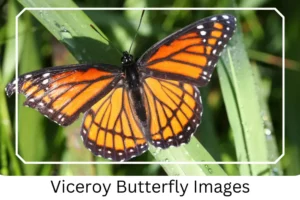Viceroy (Limenitis archippus)
The Viceroy Butterfly, known scientifically as Limenitis archippus, stands out as a celebrated emblem of the butterfly world. This species garners admiration not only from dedicated lepidopterists but also from casual observers, thanks to its widespread recognition. Despite its popularity, the Viceroy is frequently mistaken for its cousin, the Monarch Butterfly, due to their striking resemblance. Thriving across North America, the Viceroy graces the skies predominantly in the late mornings and early afternoons from May through October, showcasing the beauty and complexity of nature’s designs.
Scientific Classification
- Family: Nymphalidae
- Genus: Limenitis
- Scientific Name: Limenitis archippus
Overview
The Viceroy Butterfly’s lifecycle and behaviors provide a fascinating glimpse into the adaptability and survival strategies of butterflies. Their presence is a common sight in the diverse landscapes of most of the contiguous United States, parts of Canada, and Mexico. The Viceroy’s habitat preferences include marshes, meadows, and swamps, particularly in areas abundant with willows, aspens, and poplars. This butterfly’s journey from egg to adult encapsulates a remarkable tale of mimicry and survival, engaging enthusiasts and scientists alike in the study of its habits and ecological role.
Description and Identification
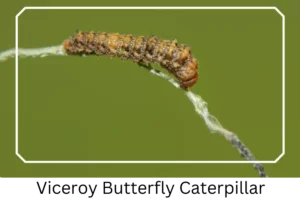
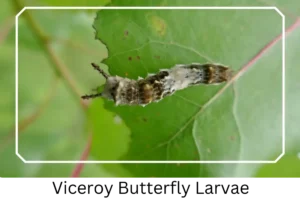 Caterpillar
Caterpillar
The Viceroy caterpillar is a master of disguise, featuring a color palette of white, brown, black, and olive green. It boasts two greenish bumps on its thorax and a pair of spines near its head. Its most remarkable adaptation is its mimicry of bird droppings, a camouflage strategy that renders it nearly invisible to predators. This nocturnal feeder’s elusive nature makes it a rare sight in the wild.
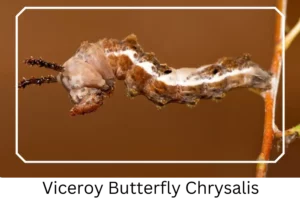 Pupa
Pupa
The chrysalis stage of the Viceroy continues the theme of mimicry, with its bird dropping resemblance. The chrysalis is marked by a white, brown, and black coloration, along with a prominent brownish bump on the abdomen, enhancing its camouflage from potential threats.
Adult Butterfly
Sexual Dimorphism: The Viceroy exhibits no visible differences between males and females, a trait that simplifies identification but intrigues scientists.
Color and Appearance: The Viceroy’s wings display a vibrant orange base adorned with black patterns similar to the Monarch’s when opened. A distinctive black line across the hind wings and a row of white dots along the black marginal band set it apart. The underside mirrors the top, albeit with a lighter base color on the hind wings.
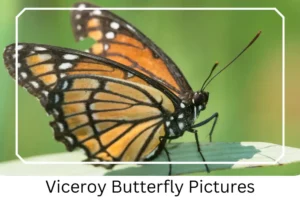
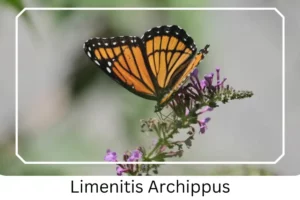 Average Wingspan: The wingspan of the Viceroy ranges from 6.6 to 7.6 cm (2.6 to 3 inches), placing it among the medium-sized butterflies.
Average Wingspan: The wingspan of the Viceroy ranges from 6.6 to 7.6 cm (2.6 to 3 inches), placing it among the medium-sized butterflies.
Flight Pattern: Viceroys are known for their average flight speed, skillfully navigating their habitats with grace and agility.
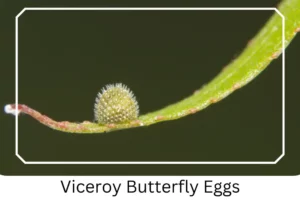
Viceroy Butterfly Eggs
Eggs
The eggs of the Viceroy Butterfly are a study in subtlety, with their pale green or yellow hue. They are laid individually, often at the tip of a host plant leaf, signaling the beginning of a new lifecycle.
Quick Facts | |
| Distribution | Widespread across the contiguous US, Canada, and Mexico. |
| Habitat | Prefers marshes, meadows, swamps, and humid areas rich in willow, aspen, and poplar trees. |
| Lifespan of Adults | Approximately 3 to 4 weeks. |
| Weight | Can weigh up to 0.65 grams. |
| Predators | Includes birds, frogs, spiders, bats, lizards, and small snakes. |
| Host Plants | Favors trees from the willow family such as willows (Salix), poplars, and cottonwoods (Populus). |
| Adult Diet | Primarily feeds on flower nectar. |
How to Identify Viceroy Butterfly?
Identifying a Viceroy Butterfly amidst its habitat or even in a bustling garden can be a rewarding experience. This butterfly’s distinct markings and coloration are key to distinguishing it from similar species, such as the Monarch. Look for the unique black line across the hind wings and the specific pattern of dots along the wing edges. Observing the butterfly’s behavior and preferred feeding plants can also provide clues. Viceroys often flutter lower to the ground and are commonly found around willow trees, their primary larval food source.
Did You Know?
- The Viceroy’s ability to store salicylic acid makes it an unpalatable meal for predators, showcasing an incredible evolutionary adaptation.
- The species name ‘viceroy’ cleverly contrasts with the ‘monarch,’ highlighting not only the mimicry between these two species but also their differences in size and habitat preference.
- In Florida, a special population of Viceroys exhibits a reddish-brown color, mimicking the queen and soldier butterflies, an adaptation that varies from the typical orange mimicry of the monarch.
- Research from the 1990s has highlighted the Viceroy and Monarch as examples of Müllerian mimicry, where two toxic species benefit from resembling each other, a fascinating case of evolutionary strategy.
- The Viceroy was officially named the state butterfly of Kentucky in 1990, a testament to its significance and the allure it holds for many.
Conclusion
The Viceroy Butterfly embodies the intricate beauty and complexity of the natural world. Through its lifecycle, from the camouflaged caterpillar to the striking adult, it offers a window into the wonders of adaptation and survival. Understanding and appreciating the Viceroy’s distinct characteristics not only enhances our enjoyment of nature but also underscores the importance of conserving the diverse habitats these remarkable creatures call home.


